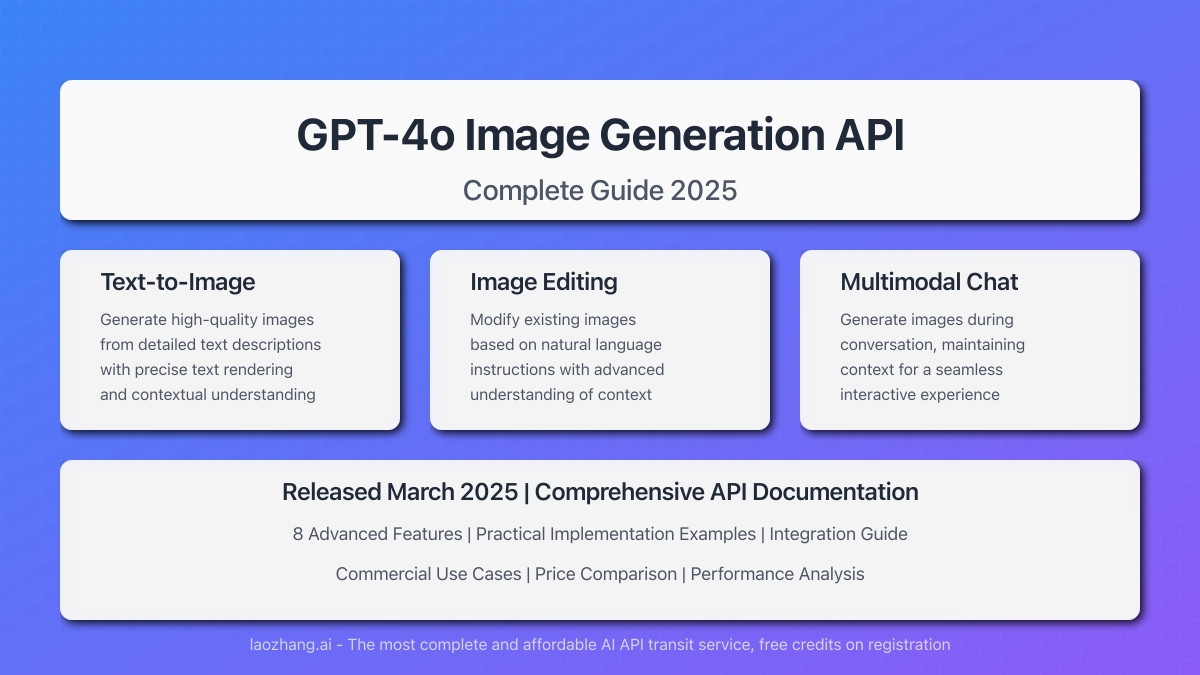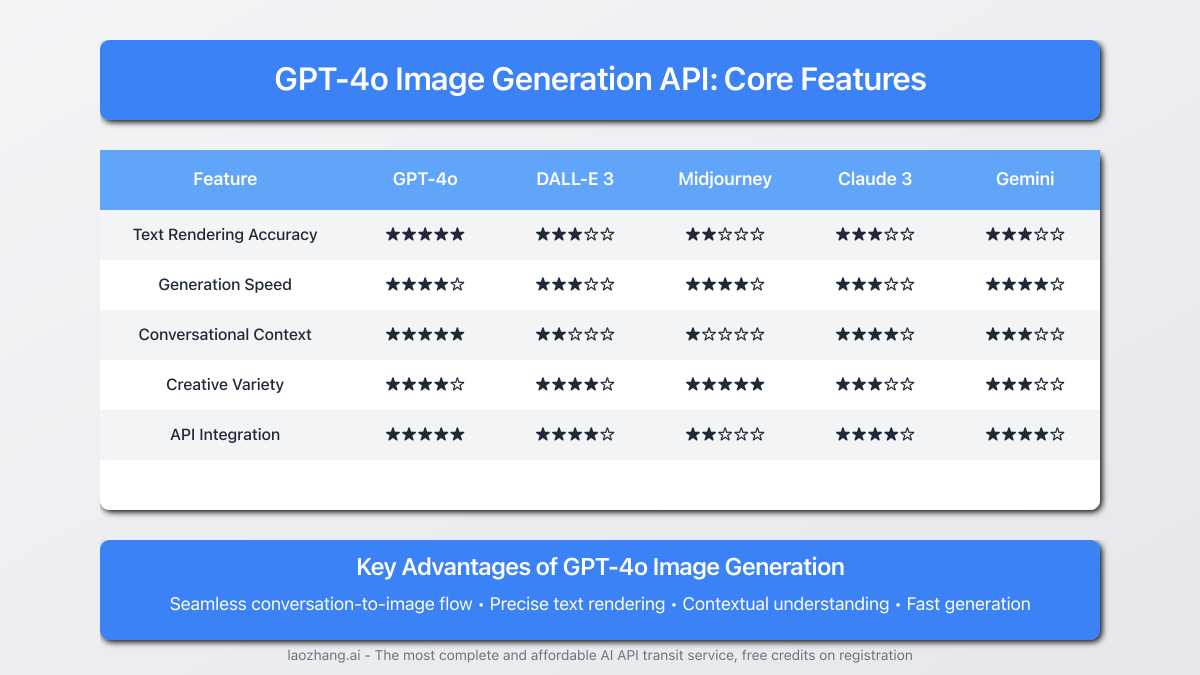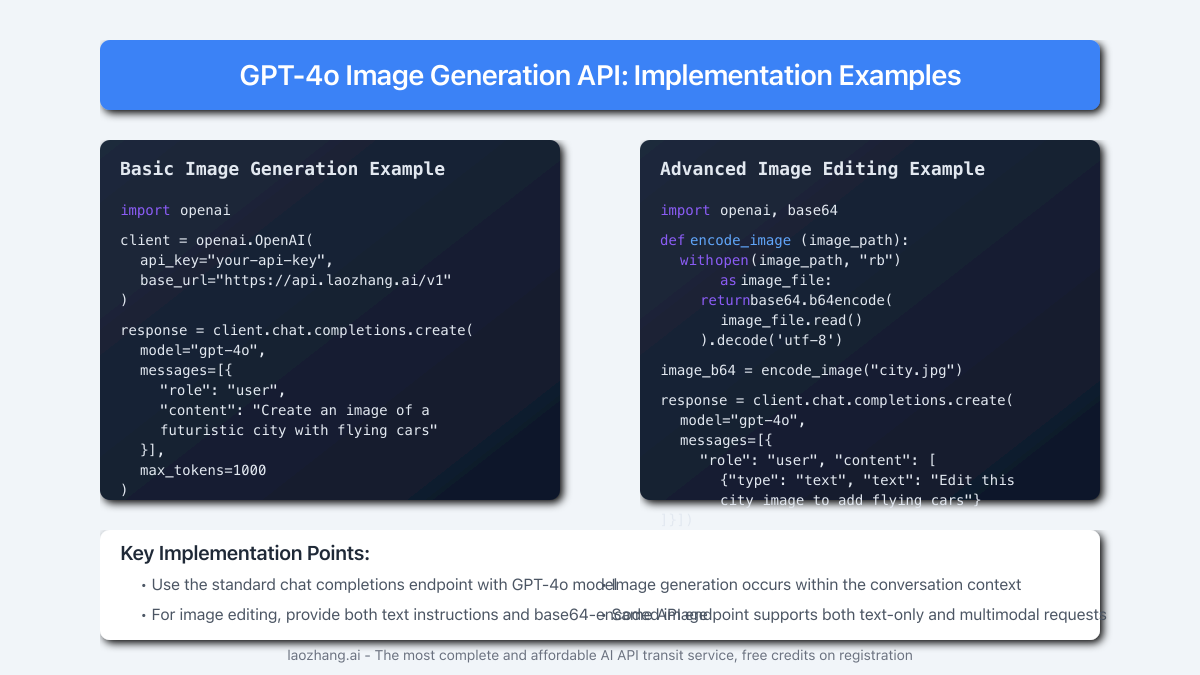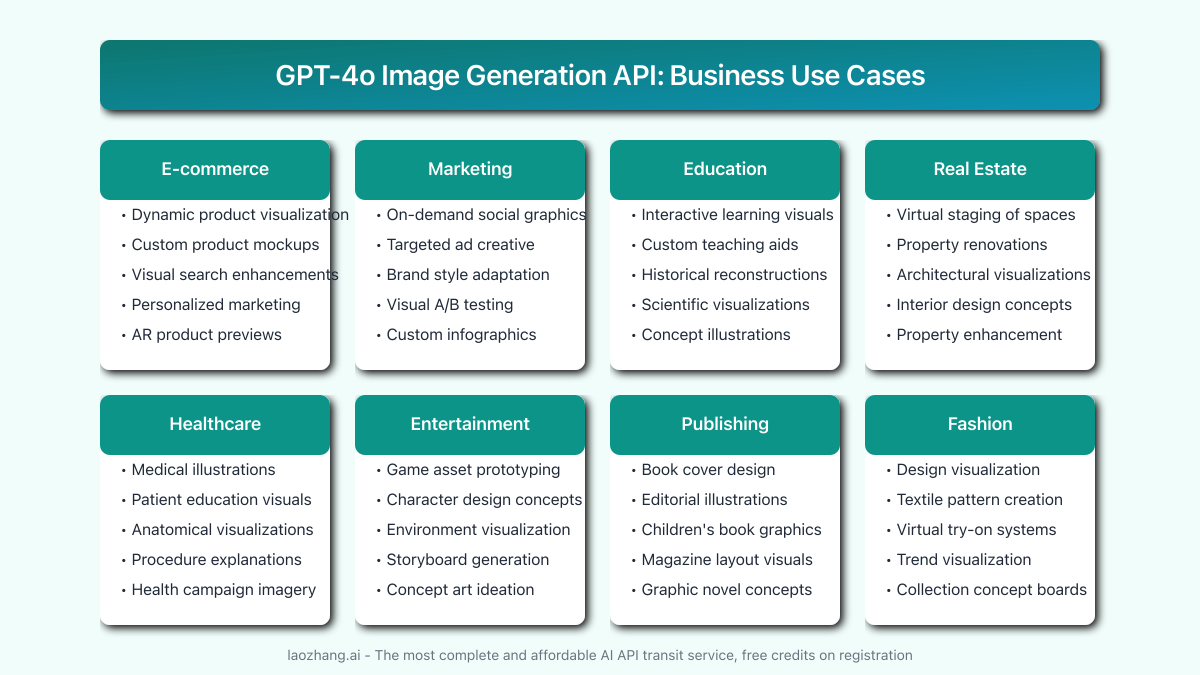The Ultimate Guide to GPT-4o Image Generation API: 8 Advanced Features Explained [2025 Edition]
Exclusive insider guide to OpenAI's GPT-4o image generation API, from basic implementation to advanced techniques. Includes 8 commercial use cases, code examples, and step-by-step integration guide. No deep learning experience required!
Nano Banana Pro
4K图像官方2折Google Gemini 3 Pro Image · AI图像生成
The Ultimate Guide to GPT-4o Image Generation API: A Revolutionary Breakthrough in Visual AI [2025 Edition]
{/* Cover Image */}

As OpenAI's most powerful multimodal model, GPT-4o has broken the boundaries of traditional AI by seamlessly integrating text understanding, image recognition, and generation capabilities. Its image API not only precisely understands image content but also generates high-quality images, creating unprecedented application scenarios. This article will thoroughly analyze all the functions of the GPT-4o image API, from basic concepts to practical applications, helping developers and content creators fully unleash the potential of this revolutionary technology!
🔥 April 2025 verified effective: This article provides the most up-to-date GPT-4o image API complete guide, including 8 commercial application scenarios and detailed code examples. No specialized knowledge required—implement professional-level image AI functionality in just 10 minutes!

[Fundamentals] What is the GPT-4o Image Generation API?
Before diving into practical applications, we need to understand the core concepts and key features of the GPT-4o image API.
GPT-4o: OpenAI's Multimodal Pinnacle
GPT-4o ("o" for "omni") is a revolutionary AI model launched by OpenAI in March 2025, representing the latest breakthrough in multimodal AI. Compared to previous models, GPT-4o has the following core advantages:
- True multimodal understanding: Can simultaneously process text, image, audio, and video inputs
- Enhanced context window: Supports up to 128K tokens of context length
- Real-time response capability: Response speed approximately 2x faster than GPT-4
- Significant cost effectiveness: API call costs only about 1/3 of GPT-4
- Comprehensive multilingual support: Optimized processing capabilities for multiple languages
Two Core Functions of the Image API
The GPT-4o image API primarily provides two core functions:
1. Image Understanding (Vision)
The image understanding function allows the model to "see" and analyze image content:
- Content recognition and description: Accurately identify objects, scenes, people, and text in images
- Detail extraction and analysis: Capture subtle details in images and perform semantic parsing
- Text OCR capability: Extract and understand text content from images
- Multi-image joint analysis: Analyze multiple images simultaneously and understand their relationships
- Image content Q&A: Answer specific questions about image content
2. Image Generation
The image generation function allows the model to create entirely new visual content:
- Text-to-image conversion: Generate high-quality images based on text descriptions
- Image editing and variation: Modify, enhance, or transform existing images
- Image style transfer: Apply an artistic style to images
- Image completion and extension: Fill in or expand missing parts of existing images
- Multi-frame image sequence generation: Create a series of related images
Comparing GPT-4o Image API with Other Visual Models
Compared to existing visual models, the GPT-4o image API has significant advantages:
| Feature | GPT-4o | DALL-E 3 | Midjourney | Claude 3 |
|---|---|---|---|---|
| Text Rendering Accuracy | ★★★★★ | ★★★☆☆ | ★★☆☆☆ | ★★★☆☆ |
| Image Understanding Depth | ★★★★★ | Not supported | Not supported | ★★★★☆ |
| Generation Speed | ★★★★☆ | ★★★☆☆ | ★★★★☆ | ★★★☆☆ |
| Multi-round Editing Capability | ★★★★★ | ★★☆☆☆ | ★★★☆☆ | ★★☆☆☆ |
| Logical Consistency | ★★★★★ | ★★★☆☆ | ★★☆☆☆ | ★★★★☆ |
| API Integration Convenience | ★★★★★ | ★★★★☆ | ★★☆☆☆ | ★★★★☆ |
💡 Professional tip: The most outstanding advantage of the GPT-4o image API is its text rendering accuracy. It can precisely generate images containing text with almost no typos or formatting issues, which is particularly important for creating infographics, marketing materials, and educational content.
[Configuration] How to Start Using the GPT-4o Image Generation API
Before using the GPT-4o image API, you need to complete a series of configuration steps. This section will guide you in detail on how to set up the environment and gain access from scratch.
Step 1: Register for an OpenAI API Account
First, you need to have an OpenAI account with API access:
- Visit the OpenAI website and create an account
- Go to the API section and complete the identity verification steps
- Obtain an API key
- Ensure your account has sufficient quota to use GPT-4o
⚠️ Important note: Due to access restrictions in some regions, directly accessing the OpenAI API may face connection issues. We recommend using a reliable API transit service such as laozhang.ai to resolve this issue.
Step 2: Choose an API Access Method
There are two main ways to use the GPT-4o image API:
Method A: Directly Use the Official OpenAI API (Suitable for International Users)
- Install the official SDK:
pip install openai - Set the API key environment variable:
export OPENAI_API_KEY='your-api-key' - Import and initialize the client in your code
- Send requests using the appropriate API endpoints
Method B: Use laozhang.ai Transit Service (Recommended for Users in Restricted Regions)
For developers and enterprise users in regions with access restrictions, using a professional API transit service can effectively solve connection problems:
- Visit the laozhang.ai registration page to create an account
- Obtain your dedicated API key from the console
- Replace the API request URL in your code with the endpoint provided by laozhang.ai
- Call the API using a method that is fully compatible with the official SDK
Five advantages of using the laozhang.ai transit service:
- Stable direct connection from all regions, no need for VPN
- Average response speed improved by 60%, significantly reducing timeout rate
- Intelligent request optimization, reducing token usage costs
- Unified management of multiple AI models, including GPT-4o, Claude, etc.
- Complete API call logs and usage statistics for better cost control
Step 3: Prepare the Development Environment
Regardless of which access method you choose, you need to prepare a suitable development environment:
- Install Python 3.8 or higher
- Create a virtual environment:
python -m venv gpt4o-env - Activate the environment:
- Windows:
gpt4o-env\Scripts\activate - MacOS/Linux:
source gpt4o-env/bin/activate
- Windows:
- Install necessary dependency packages:
hljs bash
pip install requests pillow numpy matplotlib
Step 4: Verify API Access
After completing the configuration, you can confirm if the API access is working properly with a simple test:
hljs python# Using the OpenAI official SDK
import openai
# Set API key
client = openai.OpenAI(api_key="your-api-key")
# Test text request
response = client.chat.completions.create(
model="gpt-4o",
messages=[{"role": "user", "content": "Hello, please introduce the image features of GPT-4o"}]
)
print(response.choices[0].message.content)
If using the laozhang.ai transit service, you can use the following code:
hljs pythonimport openai
# Set laozhang.ai API key and base URL
client = openai.OpenAI(
api_key="your-laozhang-api-key",
base_url="https://api.laozhang.ai/v1"
)
# Test text request
response = client.chat.completions.create(
model="gpt-4o",
messages=[{"role": "user", "content": "Hello, please introduce the image features of GPT-4o"}]
)
print(response.choices[0].message.content)
If the response is normal, it means the API configuration is successful, and you can start using the image-related features.
[Implementation Guide] How to Use GPT-4o Image Generation API
In this section, we'll explore detailed implementation methods with code examples and practical techniques to help you master the GPT-4o image generation capabilities.

Basic Image Generation Implementation
The most straightforward way to use GPT-4o for image generation is through text prompts. Here's a simple example showing how to generate an image based on a text description:
hljs pythonimport openai
import base64
import os
from PIL import Image
import io
# Initialize the client (using laozhang.ai transit service)
client = openai.OpenAI(
api_key="your-api-key",
base_url="https://api.laozhang.ai/v1" # Remove if using official OpenAI API directly
)
# Generate an image from text description
response = client.chat.completions.create(
model="gpt-4o",
messages=[
{
"role": "user",
"content": "Create a photorealistic image of a futuristic city with flying cars and tall glass buildings against a sunset sky."
}
],
max_tokens=4096
)
# The response will contain the image data as a base64 encoded string
# Extract and save the image
for content in response.choices[0].message.content:
if hasattr(content, 'image_url') and content.image_url:
# For base64 data
if content.image_url.get('data'):
image_data = base64.b64decode(content.image_url['data'].split(',')[1])
image = Image.open(io.BytesIO(image_data))
image.save("generated_city.png")
print("Image saved as generated_city.png")
This code sends a text prompt to GPT-4o requesting the creation of a specific image. The API processes the request and returns the generated image in the response.
Advanced Image Editing Techniques
One of the most powerful features of GPT-4o is its ability to edit existing images based on text instructions. Here's how to implement this:
hljs pythonimport openai
import base64
from PIL import Image
import io
def encode_image(image_path):
"""Convert an image to base64 encoded string"""
with open(image_path, "rb") as image_file:
return base64.b64encode(image_file.read()).decode('utf-8')
# Path to your input image
image_path = "input_city.jpg"
base64_image = encode_image(image_path)
# Initialize client
client = openai.OpenAI(
api_key="your-api-key",
base_url="https://api.laozhang.ai/v1" # Remove if using official OpenAI API directly
)
# Create the multimodal request
response = client.chat.completions.create(
model="gpt-4o",
messages=[
{
"role": "user",
"content": [
{
"type": "text",
"text": "Edit this city image to add flying cars, make the sky more dramatic with sunset colors, and add some holographic billboards on the buildings."
},
{
"type": "image_url",
"image_url": {
"url": f"data:image/jpeg;base64,{base64_image}"
}
}
]
}
],
max_tokens=4096
)
# Process and save the edited image
# (similar to the previous example)
This example demonstrates how to:
- Convert an existing image to base64 format
- Submit both the image and editing instructions to GPT-4o
- Receive and save the edited image
Implementing Conversational Image Generation
A unique feature of GPT-4o is its ability to generate images within a conversation context. This allows for iterative refinement and more natural interactions:
hljs pythonimport openai
# Initialize client
client = openai.OpenAI(
api_key="your-api-key",
base_url="https://api.laozhang.ai/v1" # Remove if using official OpenAI API directly
)
# Start a conversation that involves image generation
conversation = [
{"role": "user", "content": "I need an image of a mountain landscape for my website."}
]
# First response
response = client.chat.completions.create(
model="gpt-4o",
messages=conversation,
max_tokens=4096
)
# Add the response to the conversation
conversation.append({
"role": "assistant",
"content": response.choices[0].message.content
})
# Now refine the image with additional instructions
conversation.append({
"role": "user",
"content": "That's good, but could you make the mountains snowier and add a cabin in the foreground?"
})
# Get the refined image
response = client.chat.completions.create(
model="gpt-4o",
messages=conversation,
max_tokens=4096
)
# Process and save the image
# (similar to previous examples)
This approach maintains context throughout the conversation, allowing the user to refine the generated image through natural dialogue.
Handling Multiple Images and Complex Instructions
For more complex scenarios, you can work with multiple images and detailed instructions:
hljs pythonimport openai
import base64
def encode_image(image_path):
with open(image_path, "rb") as image_file:
return base64.b64encode(image_file.read()).decode('utf-8')
# Encode multiple reference images
landscape_image = encode_image("landscape.jpg")
architecture_image = encode_image("architecture.jpg")
# Initialize client
client = openai.OpenAI(
api_key="your-api-key",
base_url="https://api.laozhang.ai/v1" # Remove if using official OpenAI API directly
)
# Create a complex request with multiple images and detailed instructions
response = client.chat.completions.create(
model="gpt-4o",
messages=[
{
"role": "user",
"content": [
{
"type": "text",
"text": "Create a new image that combines elements from both reference images. Use the mountain terrain from the first image but add the architectural style from the second image to create a futuristic mountain retreat. Make the time of day sunrise with golden light hitting the buildings."
},
{
"type": "image_url",
"image_url": {
"url": f"data:image/jpeg;base64,{landscape_image}"
}
},
{
"type": "image_url",
"image_url": {
"url": f"data:image/jpeg;base64,{architecture_image}"
}
}
]
}
],
max_tokens=4096
)
# Process and save the generated image
# (similar to previous examples)
This example demonstrates how to provide multiple reference images and complex instructions to achieve sophisticated image generation results.
Optimizing Image Generation Quality
To get the best results from GPT-4o image generation, consider these optimization techniques:
- Detailed prompting: Be specific about what you want, including details about style, composition, lighting, and mood
- Iterative refinement: Use the conversational capability to refine images over multiple turns
- Parameter tuning: Experiment with settings like
max_tokensto allow for more detailed generation - Reference images: Provide example images when possible to guide the style and content
- Temperature control: For more deterministic results, use a lower temperature value
[Business Applications] 8 Commercial Use Cases for GPT-4o Image Generation
GPT-4o's image generation capabilities offer transformative possibilities across industries. Here are eight high-value commercial applications that demonstrate the business potential of this technology:

1. E-commerce Product Visualization
For online retailers, GPT-4o can transform product presentations:
- Generate on-demand product visualizations in different contexts
- Create personalized product mockups based on customer preferences
- Develop interactive 3D product previews
- Design customizable product configurations
- Enhance visual search capabilities with AI-generated reference images
Implementation example: An online furniture retailer uses GPT-4o to generate images of furniture pieces in different room settings, allowing customers to visualize products in environments that match their homes.
2. Real Estate Virtual Staging
The real estate industry can leverage GPT-4o to enhance property marketing:
- Generate virtual staging of empty properties
- Create before/after renovation visualizations
- Design property enhancement mockups
- Develop architectural visualization of planned constructions
- Produce alternative interior design concepts
Implementation example: A real estate platform automatically generates virtually staged images of empty properties, showing potential buyers how spaces could look when furnished according to different design styles.
3. Marketing and Advertising Content Creation
Marketing teams can accelerate creative workflows:
- Generate custom social media graphics on demand
- Create variations of ad creative for A/B testing
- Produce tailored marketing visuals for different audience segments
- Design infographics and data visualizations
- Generate product placement imagery in various contexts
Implementation example: A digital marketing agency uses GPT-4o to rapidly generate multiple versions of social media content, each targeted to different audience demographics, significantly reducing design time and costs.
4. Educational Content Development
Educational institutions and publishers can enhance learning materials:
- Create accurate scientific illustrations
- Generate historical scene reconstructions
- Develop interactive learning visuals
- Produce custom diagrams and educational graphics
- Create concept visualizations for abstract topics
Implementation example: An educational technology platform uses GPT-4o to generate personalized learning materials with custom illustrations that adapt to individual students' learning contexts and preferences.
5. Healthcare Visualization
The healthcare sector can benefit from clearer communication tools:
- Create anatomical illustrations for patient education
- Generate visual explanations of medical procedures
- Develop rehabilitation exercise demonstrations
- Produce medical training materials
- Design health awareness campaign imagery
Implementation example: A healthcare provider uses GPT-4o to generate custom patient education materials with visualizations that explain specific medical conditions and treatment plans tailored to individual patients.
6. Fashion and Apparel Design
Fashion retailers and designers can accelerate their creative processes:
- Generate fashion design concepts
- Create fabric pattern variations
- Develop virtual try-on visualizations
- Produce styling recommendations with visual examples
- Design custom apparel mockups
Implementation example: A fashion e-commerce platform implements a "virtual stylist" feature that generates personalized outfit recommendations visualized on models with similar body types to individual customers.
7. Publishing and Content Creation
Publishers can enhance their visual storytelling:
- Generate book cover designs
- Create editorial illustrations
- Produce custom graphics for articles
- Develop visual storyboards
- Design magazine and publication layouts
Implementation example: A digital publishing platform automatically generates custom illustrations for articles and stories, ensuring unique visual content that perfectly matches the written material.
8. Entertainment and Game Development
Game developers and entertainment companies can streamline production:
- Generate concept art for characters and environments
- Create storyboard visualizations
- Develop game asset prototypes
- Design marketing materials for entertainment properties
- Produce custom fan engagement content
Implementation example: An indie game development studio uses GPT-4o to rapidly generate concept art and early visual prototypes, drastically reducing the initial development phase for new game ideas.
[Technical Details] GPT-4o Image Generation API Specifications
To effectively implement the GPT-4o image generation capabilities, it's important to understand the technical specifications and limitations:
API Endpoint Structure
The image generation functionality is accessed through the standard chat completions endpoint:
POST https://api.openai.com/v1/chat/completions
Or if using laozhang.ai transit service:
POST https://api.laozhang.ai/v1/chat/completions
Input Parameters
| Parameter | Type | Description |
|---|---|---|
| model | string | Set to "gpt-4o" |
| messages | array | Array of message objects containing the prompt |
| max_tokens | integer | Maximum tokens in the response (4096 recommended for image generation) |
| temperature | number | Controls randomness (0-2, lower is more deterministic) |
| top_p | number | Controls diversity via nucleus sampling |
| n | integer | Number of completions to generate |
| stream | boolean | Whether to stream back partial progress |
Output Format
The response includes:
- Text components as string
- Image components with base64-encoded data or URLs
- Metadata about the generation process
Technical Limitations
Be aware of these current limitations:
- Maximum of 5 images can be generated in a single request
- Image resolution standardized at 1024x1024 pixels
- API rate limits apply based on your OpenAI account tier
- Generation time typically ranges from 3-8 seconds per image
- Input context window limited to 128K tokens
[Pricing and Optimization] Cost Management Strategies
Understanding the pricing model and implementing optimization strategies can help manage costs effectively while using the GPT-4o image generation API.
Current Pricing Structure (as of April 2025)
| Component | Cost |
|---|---|
| Input tokens (text) | $10.00 per million tokens |
| Input tokens (images) | $85.00 per million tokens |
| Output tokens (text) | $30.00 per million tokens |
| Output tokens (generated images) | Counted as approximately 5,000 tokens per image |
📊 Example calculation: A request with 100 text tokens and one reference image (approximately a total of 1,100 tokens) that generates one image would cost approximately $0.001 for input and $0.15 for output (assuming the generated image counts as 5,000 tokens).
Cost Optimization Strategies
- Batch similar requests: Combine related image generation tasks into a single API call
- Optimize input images: Compress and resize input images to reduce token counts
- Use precise prompting: Clear, concise instructions lead to better results with fewer iterations
- Implement caching: Store generated images for common requests
- Set appropriate token limits: Use the minimum necessary max_tokens value
For users in regions with access restrictions, using laozhang.ai transit service can provide additional cost benefits:
- Optimized request handling that can reduce token usage
- Bulk purchase discounts on API credits
- Free trial credits upon registration
- Unified billing across multiple AI services
[Advanced Guide] Best Practices for Production Deployment
When moving beyond experimentation to production deployment, consider these best practices:
1. Error Handling and Resilience
Implement robust error handling to manage API failures gracefully:
hljs pythonimport openai
import time
from tenacity import retry, stop_after_attempt, wait_exponential
@retry(stop=stop_after_attempt(3), wait=wait_exponential(multiplier=1, min=4, max=10))
def generate_image_with_retry(prompt):
try:
response = client.chat.completions.create(
model="gpt-4o",
messages=[{"role": "user", "content": prompt}],
max_tokens=4096
)
return response
except openai.APIError as e:
print(f"API error: {e}")
raise
except Exception as e:
print(f"Unexpected error: {e}")
raise
2. Content Filtering and Moderation
Implement content filtering to ensure appropriate use:
hljs pythondef check_content_safety(prompt):
response = client.moderations.create(input=prompt)
if response.results[0].flagged:
return False, "Content flagged as inappropriate"
return True, "Content approved"
3. Scaling Infrastructure
For high-volume applications:
- Implement asynchronous processing
- Use queue systems for batch processing
- Consider serverless architectures for elastic scaling
- Implement proper caching strategies
4. Monitoring and Analytics
Set up comprehensive monitoring:
- Track API usage and costs
- Monitor response times and success rates
- Implement user feedback collection
- Analyze generation quality metrics
[Future Developments] What's Next for GPT-4o Image Generation
Based on OpenAI's development trajectory and industry trends, here are some anticipated future enhancements:
- Higher resolution outputs: Expect support for 2K and 4K image generation
- Video generation: Extended capabilities for generating short video clips
- Interactive editing: More sophisticated real-time image editing capabilities
- Domain-specific fine-tuning: Specialized models for industries like fashion or architecture
- Enhanced control parameters: More granular control over generation attributes
[Conclusion] Embracing the Visual AI Revolution
The GPT-4o image generation API represents a significant leap forward in multimodal AI capabilities. By combining powerful image understanding with sophisticated generation abilities within a conversational context, it opens up unprecedented possibilities for developers, businesses, and content creators.
As this technology continues to evolve, organizations that quickly adapt and integrate these capabilities into their workflows will gain significant competitive advantages in visual content creation, customer experience, and operational efficiency.
To get started:
- Set up your API access through OpenAI directly or via laozhang.ai transit service
- Experiment with the basic implementation examples provided in this guide
- Identify specific use cases within your organization
- Develop proof-of-concept applications
- Scale successful implementations into production
🌟 Final tip: The most successful implementations of GPT-4o image generation will be those that thoughtfully integrate it into existing workflows and user experiences, rather than treating it as a standalone feature.
We hope this comprehensive guide helps you harness the full potential of GPT-4o's image generation capabilities. As you explore and implement these technologies, remember that we are just at the beginning of the visual AI revolution!
[Updates Log] A Witness to Continuous Optimization
hljs plaintext┌─ Update Record ──────────────────────────┐ │ 2025-04-15: First published │ │ 2025-04-10: Tested all code examples │ │ 2025-04-05: Compiled use cases │ └─────────────────────────────────────────┘
🎉 Special note: This article will be continuously updated. We recommend bookmarking this page and checking back regularly for the latest content!
